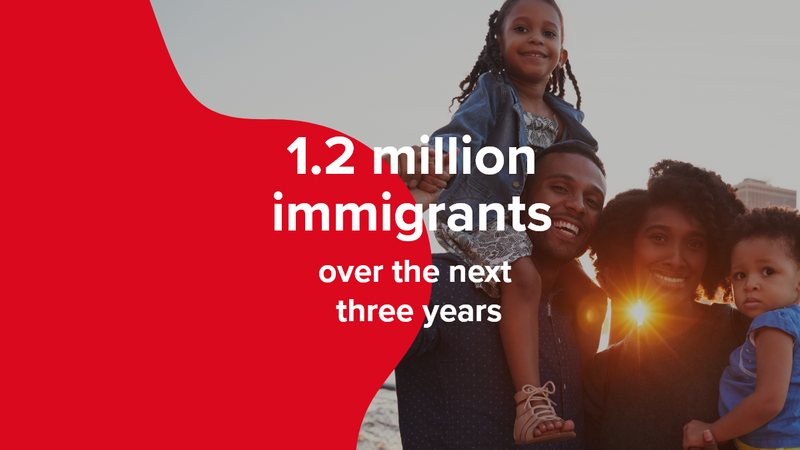It’s been a 2020 kind of year. We have been trying to anticipate the response from the Canadian government regarding immigration, given the United States immigration ban, but we could never have anticipated this. The Canadian government wants to grow the economy but with a population of only 37.4 million in the second-largest country in the world, that is proving to be quite challenging. That is why the Immigration and Refugee Council of Canada (IRCC) has been tasked with welcoming over 1.2 million immigrants over the next three years. That’s right, the IRCC will be awarding permanent residency to a little over 400,000 immigrants every year until 2023. If you are thinking about immigrating to Canada, your timing couldn’t be better.
The Canadian immigration targets for the next 3 years are:
- 2021 - 401,000 immigrants
- 2022 - 411,000 immigrants
- 2023 - 421,000 immigrants
Canada has one of the oldest populations, with 18 percent over the age of 65. That coupled with one of the lowest birth rates, 1.47 children per adult woman and you can see why we are struggling to expand. The solution is obvious, invite hard-working and skilled foreigners to become a part of our nation, to build an even better tomorrow for our next generation, and yours.
If you want to check your eligibility for Canadian immigration and learn more about the permanent residency programs you may qualify for, follow the link below.
So, How Can I Immigrate to Canada?

We don’t know the numbers that will be allocated to the various immigration programs and pilots just yet. An estimated 60% of the annual target will be allocated to economic immigration programs economic class programs and if history is anything to go by, the Express Entry System will take the lion's share of Invitations to Apply (ITA’s) for permanent residency.
We may also see the extension of programs such as the Atlantic Immigration Pilot, which has been highly successful at attracting immigrants of all skill levels to the region. Which program will ultimately see you issued an ITA ultimately depends on where you want to live and your occupation, so let’s take a look at some of the immigration programs to get an idea of where you may fit in.
Express Entry System
Canada’s premier economic migration program is the Express Entry System. Made up of the programs, the system aims to offer skilled foreign invitations to apply for permanent residency in as little as six months from time of application submission. The system is highly competitive and candidates are invited based on a Comprehensive Ranking System (CRS) score, so you will need to maximize your CRS score if you want the opportunity to apply for permanent residency in Canada.
You don’t need a job offer in Canada to earn an ITA, though getting one would greatly improve your chances. The system works thus; you create a profile for yourself, provide information relevant to your qualifications, work experience, language capabilities and a few other factors. Your profile is then entered into one of three pools with other candidates, if your score is high enough, you will be selected and issued an ITA. If you are selected, all you have to do is provide the documents to back up your application and you will be awarded permanent residency in Canada. The three programs or pools are:
- Federal Skilled Worker Program - for people with experience in managerial and professional roles such as lawyers, accountants and engineers.
- Federal Skilled Trades Program - for qualified tradesmen with at least two years of experience. You will require a job offer OR certification from a provincial Canadian regulatory body.
- Canada Experience Class - If you have at least one year of experience working in Canada in one of the categories above, you are eligible for this preferred program.
Atlantic Immigration Pilot
If you find that you aren’t eligible for the Express Entry System, or maybe you don’t think your CRS score will give you a fighting chance, no need to worry. There are numerous pilot programs as well as the Provincial Nominee Program which allow semi-skilled foreign workers with job offers in Canada to become permanent residents in Canada.
One such program is the Atlantic Immigration Pilot (AIP). In 2017, the four provinces of Newfoundland & Labrador, New Brunswick, Prince Edward Island, and Nova Scotia that make up Atlantic Canada created the AIP, a program with the aim of bringing the benefits of economic migration to the region. Initially, the program was set to run for two years, but in 2019 it was extended for a further two years.
Currently, the program will expire in March 2021, and while it has been very successful, we can only hope it will be renewed again. In the meantime, if you could picture yourself living and working in Atlantic Canada, we would highly recommend getting a jump on your application before the deadline. The three available categories are:
- Atlantic International Graduate Program - for graduates of post-secondary institutions in one of the Atlantic provinces with a qualification of at least 2 years. No work experience is required.
- Atlantic High Skilled Program - if you have a job offer and at least one year of work experience in a managerial, professional, or skilled trade job. You will require some experience and the equivalent of a Canadian high school diploma
- Atlantic Intermediate Skilled Program - you only require a job offer in a semi-skilled position that requires on the job training. You must also have at least one year of experience in this type of job and the equivalent of a Canadian high school diploma. Semi-skilled jobs include, but aren’t limited to:
- Cooks, butchers, and bakers;
- Food and beverage servers i.e. waiters, barmen, counter attendants;
- Truck drivers;
- Nurse aides and orderlies.




